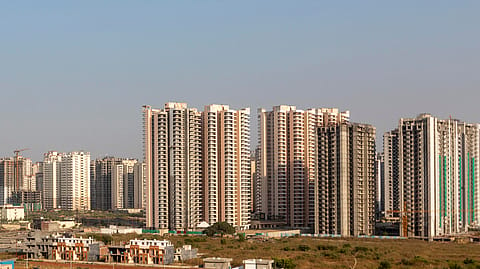Real estate as a growth multiplier: Powering India’s $7-trillion economic ambition
As urbanisation reshapes housing and infrastructure needs, overcoming challenges in land acquisition and sustainability will be vital for the sector to drive inclusive and resilient economic growth.

India today stands on the brink of an extraordinary transformation. The aspiration to become a $7-trillion economy by 2030 is bold yet achievable, provided the right engines are fuelled with the right mix of urgency and vision. Among all sectors, real estate stands out, not just as another sector, but the very foundation on which the country’s consumption, infrastructure, and job creation rest.
Policy reforms over the past decade have been game-changers. The Real Estate Regulatory Act (RERA) has brought accountability and transparency; Goods and Services Tax (GST) and the Insolvency and Bankruptcy Code (IBC) have streamlined processes; and the digitisation of land records has reduced opacity. The introduction of Real Estate Investment Trusts (REITs) and infrastructure investment trusts (InvITs) has opened the gates to global capital, anchoring confidence in the market.
Real estate has a significant multiplier effect that permeates through the nation’s social and economic fabric. From housing to offices, from retail to industrial parks, from metro networks to smart cities, it powers both aspiration and productivity. The critical question is whether India can harness this momentum fast enough to meet its ambitious goals.
Why real estate matters more than ever
The numbers already speak volumes. In FY25, real estate contributed nearly 7.5% of India’s GDP, with projections suggesting this could rise to as much as 13% by 2030. Equally significant, the construction sector is the country’s second-largest employer, providing jobs to over 60 million people, second only to agriculture.
Beyond jobs, the sector is a magnet for investment. Private equity inflows, institutional capital, and new instruments like REITs and InvITs are deepening the financial dominance of Indian real estate. Global investors are finding India irresistible; a young population, steady domestic demand, and resilient returns are tilting the balance decisively in our favour. However, India as an investment destination requires patient capital.
Housing: From shelter to aspirational asset
Recommended Stories
Rapid urbanisation is reshaping the country’s housing needs. By 2030, nearly 40% of Indians will live in cities, driving demand across the spectrum—from affordable units to luxury homes. Government initiatives such as PMAY have been critical in enabling access for the economically weaker sections. Yet, the demand-supply gap remains wide, requiring a sharper policy and financing push.
On the other end of the spectrum, premium housing is booming. Rising incomes and lifestyle aspirations mean homes are no longer just shelter, they are wealth creators and status markers. This dual narrative of affordability and aspiration will continue to define the housing market over the next decade.
Offices: India’s global calling card
India’s office market is perhaps the clearest signal of our emergence as a global powerhouse. The IT/ITeS sector (third-party IT Services), BFSI, and the rapidly expanding global capability centres (GCCs) have positioned us as not just the back office, but increasingly the innovation hub of the world.
With over 1 billion sq. ft of office stock, India is now among the top global markets. Crucially, this growth is not one-sided. While multinational corporations are expanding, domestic businesses and startups are adding balance, ensuring resilience even in a volatile global economy. New frontiers such as flexible workspaces, ESG-compliant buildings, and transit-oriented developments are redefining how and where we work.
Retail real estate: Beyond shops, a growth ecosystem
Retail consumption in India has grown manifold over the long term, and if history is any guide, the party is far from over. What’s particularly striking in recent years is the surge in rural consumption—a trend that signals not just more buyers, but a demand for more experiences and, inevitably, more real estate.
It is important not to mistake retail for just shops or malls. It is an entire ecosystem, from manufacturing and industries to logistics, supply chains, and the final act of retailing. Every purchase is underpinned by layers of real estate assets: factories where products are made, warehouses where they are stored, transport hubs where they move, and finally, the retail spaces where they are sold.
This expansion is visible across geographies. Tier II and Tier III cities are seeing malls evolve into lifestyle destinations, while in metros, premiumisation is driving the entry of luxury and global brands. The scale of retail real estate is therefore both wide and deep, touching every stage of India’s consumption journey and reinforcing its role as a cornerstone of long-term economic growth.
The future course of real estate
Yet challenges persist. Land acquisition remains complex and litigious while financing challenges continue to weigh on both the supply and demand sides of the business. The sector cannot ignore its environmental footprint, as it contributes significantly to ecological degradation. Therefore, an elaborate environmental policy aimed at enablement rather than obstruction is the crying need of the hour. In addition, approvals must be expedited, and we cannot emphasise enough the need for technology-driven processes that enhance and not compromise sustainability. Most critically, urban governance must scale up to manage the pace of change that India’s cities are undergoing.
Real estate is not merely a mirror reflecting economic progress; it is the catalyst driving it. Every home built, every office occupied, every mall opened, every metro completed adds to the cumulative momentum of the Indian growth story.
The path to $7 trillion will not be without turbulence. Global uncertainties, climate pressures, and financial risks will test our resilience. But with visionary policy, bold infrastructure investments, and private sector innovation, real estate can anchor India’s next big leap. The real question is not whether real estate will power India’s economic rise—it already is. The question is how quickly we can unlock its full potential to shape a future that is not just wealthier, but also more inclusive, sustainable, and resilient.
(The author is Chairman and Managing Director, Knight Frank India. Views are personal.)